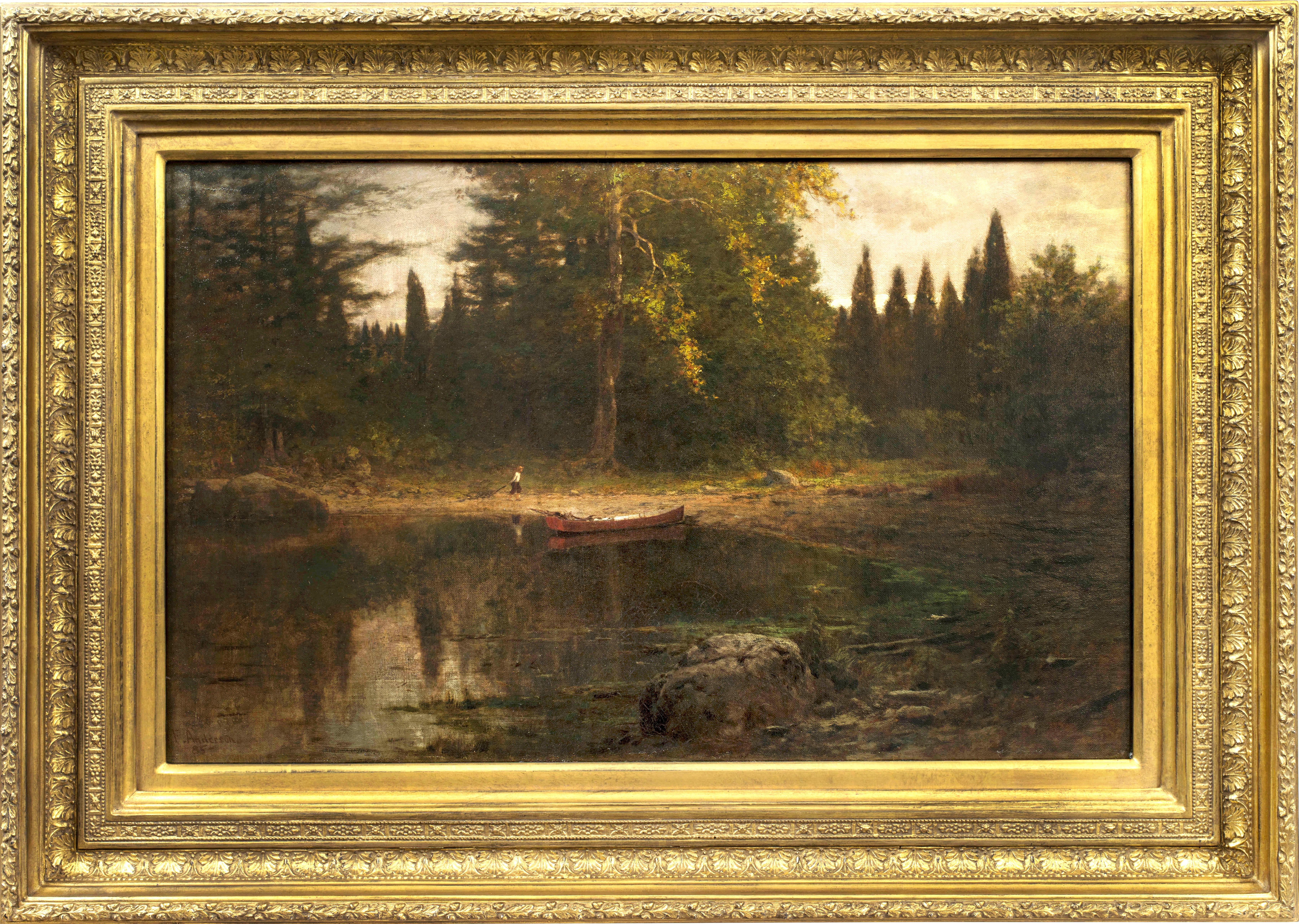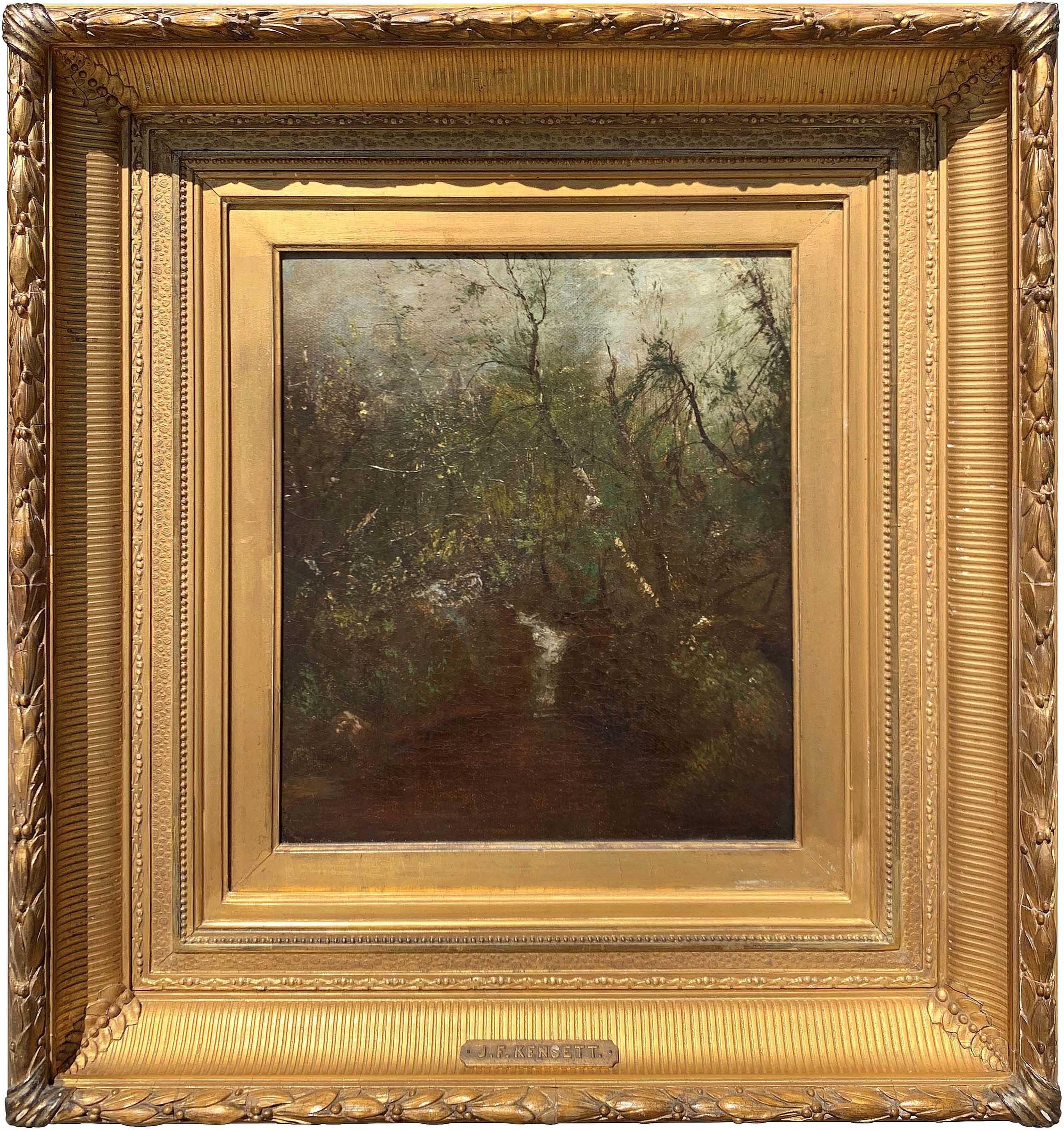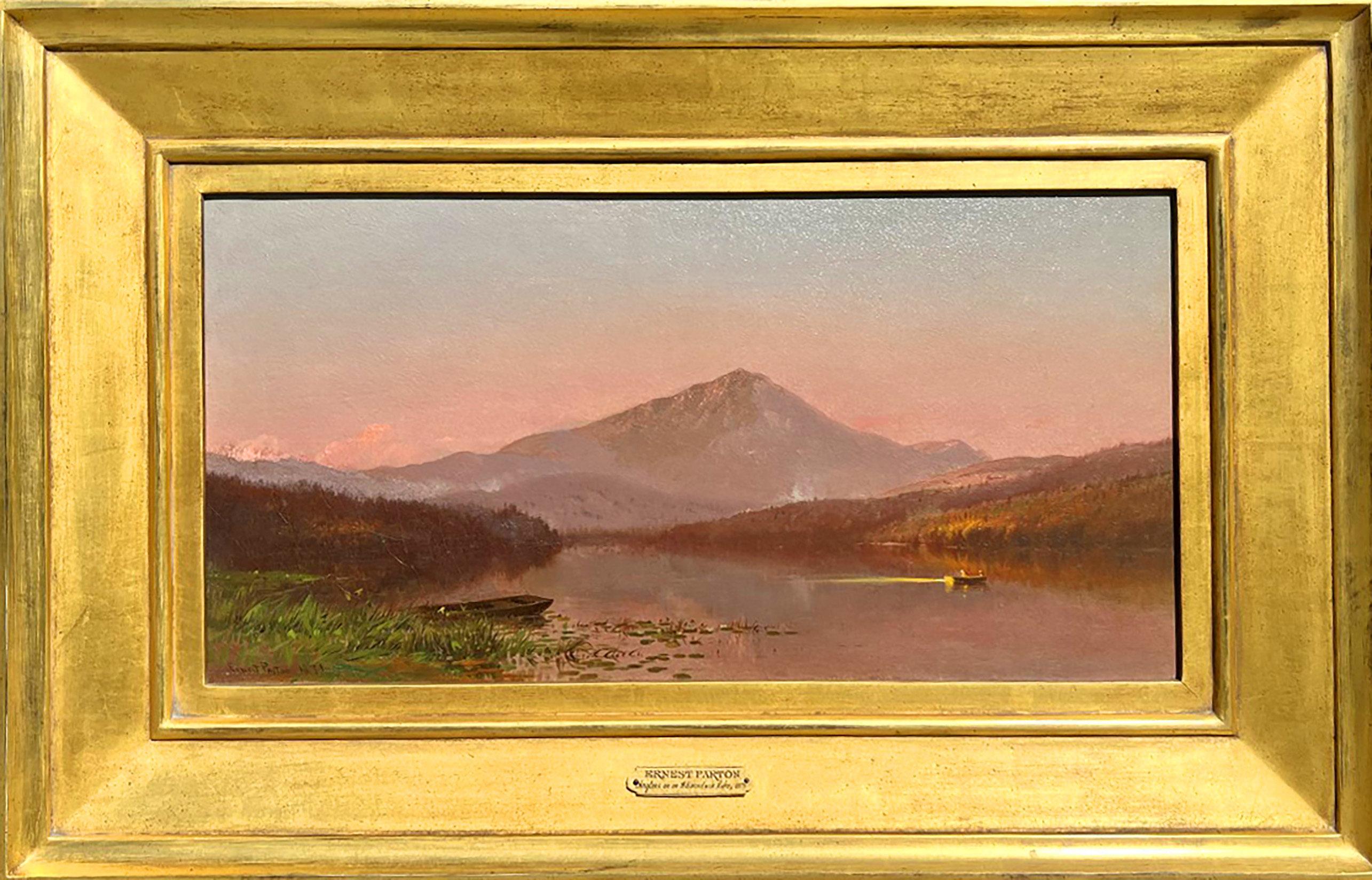Items Similar to Indians in a Landscape
Want more images or videos?
Request additional images or videos from the seller
1 of 5
William Mason BrownIndians in a Landscape
About the Item
Signed lower left.
Along with Martin Johnson Heade, William Mason Brown was among a very elite group of artists equally adept at landscape painting as well as still-life painting. He was born in upstate New York in 1828, in the city of Troy, where he also began his art studies under Thomas Grinnell and later with the portraitist, Abel B. Moore. In 1850, at the age of twenty two, he followed Moore to Newark, NJ, where he continued his art education. After his apprenticeship portraitist period was complete he began to paint landscapes, inspired by Thomas Cole and the romantic artists of the Hudson River School.
As the period of his landscape production largely covers the years of 1850 to 1869 his style of painting most resembles that of the Pre-Raphaelites. That is not surprising, especially when one learns that Brown lived in Brooklyn, home to most of the Pre-Raphaelites, and painted microscopic detail with equal fervor. It is not known how involved he was in the Society of Truth in Art, but he is extensively included in Linda Ferber's 1985 landmark book on the group, "The New Path, the American Pre-Raphaelites".
Ironically enough, just as the Pre-Raphaelites burned out prematurely from the exacting nature of their work, so too did William Mason Brown's landscape phase came to an early end as he switched over to still-life painting. After 1869 he primarily switched over to painting fruit and floral still-lives.
His work found its way into numerous public collections which include the Corcoran Gallery, Washington, DC; the Pennsylvania Academy of the Fine Art, Philadelphia, PA; the J.B. Speed Museum, Louisville, KY; the Haggin Museum, Stockton, CA; the Munson Williams Proctor Institute, Utica, NY; the St. Johnsbury Athenaeum, St. Johnsbury, Vermont; Cleveland Museum of Art, Cleveland, Ohio; the Hood Museum at Dartmouth College, Hanover, New Hampshire, and the Peabody Institute, Baltimore, MD. Credit: askart
- Creator:William Mason Brown (1828-1898, American)
- Dimensions:Height: 9.5 in (24.13 cm)Width: 13.5 in (34.29 cm)Depth: 3 in (7.62 cm)
- More Editions & Sizes:1 of 1Price: $15,000
- Medium:
- Movement & Style:
- Period:
- Condition:
- Gallery Location:Saratoga Springs, NY
- Reference Number:1stDibs: LU170212593792
About the Seller
4.2
Vetted Seller
These experienced sellers undergo a comprehensive evaluation by our team of in-house experts.
Established in 1992
1stDibs seller since 2015
30 sales on 1stDibs
Typical response time: 19 hours
- ShippingRetrieving quote...Ships From: Saratoga Springs, NY
- Return PolicyA return for this item may be initiated within 3 days of delivery.
More From This SellerView All
- California MillBy Hermann Ottomar HerzogLocated in Saratoga Springs, NYSigned & dated, lower left, 1869 Herman Ottomar Herzog was born in Bremen, Germany, on November 15, 1831. He studied art at the Dusseldorf Academy, starting in 1848, under several classical landscape painters. In 1855, Herzog made his first visit to Norway. The trip was a milestone in Herzog's career as it exposed him to the rugged landscape of the Norwegian wilderness and instilled in him a lifelong sense of nature that was to show in all his work. During the late 1850's and early 1860's, Herzog's fame spread throughout Europe. His paintings were collected for their dynamic realism and strong atmospheric effects. Among his patrons were several of Europe's royal families, including Queen Victoria of England and Grand Duke Alexander of Russia. He exhibited in the Paris Salon in 1863 and 1864, winning an Honorable Mention. While in Paris, it is thought that Herzog came into contact with the popular Barbizon School, whose adherents painted the grandeur and beauty of Nature in a romantic and realistic style. The effect of the Barbizon painters can also be seen in Herzog's poetic handling of mood and color. Although he was still in Europe, Herzog sent several paintings for exhibition at the Pennsylvania Academy from 1863 to 1869. He had several friends in the United States and they were developing a rather good demand for his work. It is not known exactly when Herzog decided to come to America. Sometime in the late 1860's he settled in Philadelphia. Besides wanting a developing market for his work, Herzog left Bremen due to rising political agitation by Prussia, which had just absorbed Bremen into its domain. In America, Herzog continued to paint his romantic landscapes, finding the American wilderness well suited to his style. In 1871, he traveled up the Hudson River on a painting tour. In 1873, he took his first trip west, going to Yosemite, then to Wyoming, Oregon, and along the West Coast to the Coronado Island, near the Mexican border. Herzog made several journeys west, finding each trip more fruitful than the last. He became known for his depictions of Yosemite, receiving great acclaim for a fine El Capitan, much in the style of his fellow countryman and painter Albert Bierstadt. His last trip west was in 1905, at the age of 74. In 1876, Herzog participated in the Centennial Exhibition in Philadelphia, showing a Norwegian scene and a Yosemite landscape...Category
1860s Hudson River School Landscape Paintings
MaterialsCanvas, Oil
- Fishing by the StreamLocated in Saratoga Springs, NYSigned lower rightCategory
1860s Hudson River School Landscape Paintings
MaterialsCanvas, Oil
- Forest ClearingBy Roswell Morse ShurtleffLocated in Saratoga Springs, NYSigned lower left. Most noted for his paintings of forest interiors, Roswell Shurtleff settled in Hartford, Connecticut but spent his summers painting his signature works in the Adirondacks at Keene Valley, New York. He and John Lee Fitch successfully encouraged other artists to join them including Winslow Homer, J Alden Weir, James Smillie...Category
Late 19th Century Hudson River School Landscape Paintings
MaterialsOil, Canvas
- Pleasant DayBy Joseph Antonio HekkingLocated in Saratoga Springs, NYSigned lower left J. A. Hekking was a versatile and talented landscape painter who lived in New York and Connecticut and was active from the early 1850's to the later 1870's. Hekking was a frequent participant at major exhibitions. His paintings were inspired by the Adirondack and White Mountains, Connecticut, New York views, and the Jersey shore. He worked with Frederick Rondeland. His paintings were actively acquired by important collectors including J.S. Farrand, Sarah Holderby, N.L. Lindsey, T. Foster, and George Watter Vincent Smith. Hekking exhibited at the National Academy of Design (eight paintings between 1859 and 1875); the 1865 Michigan State Fair; the Crystal Palace in New York, 1853; Cosmopolitan Art Association, 1858; Utica Art Association, 1868; Buffalo Fine Arts Academy, 1869; Boston;1869; the Buffalo YMCA, 1861 and the Chicago Industrial...Category
Late 19th Century Hudson River School Landscape Paintings
MaterialsCanvas, Oil
- AusableBy William OngleyLocated in Saratoga Springs, NYSigned lower right. A landscape and marine painter, William Ongley was born in England in 1836 and came to America with his family and settled in New York. His art studies took him ...Category
Late 19th Century Hudson River School Landscape Paintings
MaterialsCanvas, Oil
- The Cove at DuskLocated in Saratoga Springs, NYSigned and dated 1877. Although born in Jamestown, New York, Mortimer Smith would become well-known as a Detroit architect and artist by the end of the nineteenth century. Little is known of Smith's earlier years; however, scholars speculate that he studied in Oberlin and Sandusky, Ohio before moving to Detroit in 1855. There, the artist flourished and became famous for his crisp landscapes of local scenery, including his beloved winter scenes. In addition to his artistic career, Smith founded a successful architectural firm by the name of Smith, Hynchman and Grylls; Smith's reputation in the visual arts was often overshadowed by his draftsmanship as an architect. Nevertheless, he was a vital force in Detroit's arts community exhibiting his works in venues including the Detroit Art...Category
1870s Hudson River School Landscape Paintings
MaterialsCanvas, Oil
You May Also Like
- Anglers on an Adirondack Lake by Ernest Parton (American, 1845-1933)By Ernest PartonLocated in New York, NYHudson River School artist Ernest Parton's (1845-1933) "Anglers on an Adirondack Lake" is oil on canvas, measures 10 x 20 inches, and is signed and dated 1871 at the lower left. The ...Category
19th Century Hudson River School Landscape Paintings
MaterialsOil, Canvas
- Mink Hollow Brook by Hudson River Artist Jervis McEntee (American, 1828-1891)By Jervis McEnteeLocated in New York, NY"Mink Hollow Brook," by Hudson River School artist Jervis McEntee (1828-1891) depicts the lush foliage, and rocky terrain surrounding a Catskill brook. This 19th century oil paintin...Category
19th Century Hudson River School Landscape Paintings
MaterialsOil, Canvas
- Gordon Setter in a Landscape by Otto Norquist (American: 1859-1906)Located in New York, NYOtto Norquist (1859-1906) "Gordon Setter in a Landscape, 1890" Oil on canvas 22 x 27 inches Signed and dated 1890, lower right Otto Norquist was born in...Category
Late 19th Century Hudson River School Landscape Paintings
MaterialsCanvas, Oil
- Landscape in the Hudson Valley by Worthington Whittredge (American, 1820-1910)By Worthington WhittredgeLocated in New York, NYHudson River School artist Worthington Whittredge's (1820-1910) Landscape in the Hudson Valley is oil on canvas and measures 11 x 19 inches. The work is signed by the artist at the l...Category
19th Century Hudson River School Landscape Paintings
MaterialsCanvas, Oil
- Camel's Hump, Vermont, 1877 by Laura Woodward (American, 1834-1926)By Laura WoodwardLocated in New York, NYPainted by Hudson River School artist Laura Woodward (1834-1926), "Camel's Hump, Vermont" 1877 is oil on canvas and measures 14 x 24 inches. It is signe...Category
19th Century Hudson River School Landscape Paintings
MaterialsOil, Canvas
- A Day in November, 1863 by James MacDougal Hart (American: 1828–1901)By James McDougal HartLocated in New York, NYA prominent 19th century landscapist, Hudson River School painter James McDougal Hart's (1828-1901) A Day in November, 1863 is oil on canvas and measures 10.5 x 18 inches. The painti...Category
19th Century Hudson River School Landscape Paintings
MaterialsCanvas, Oil





